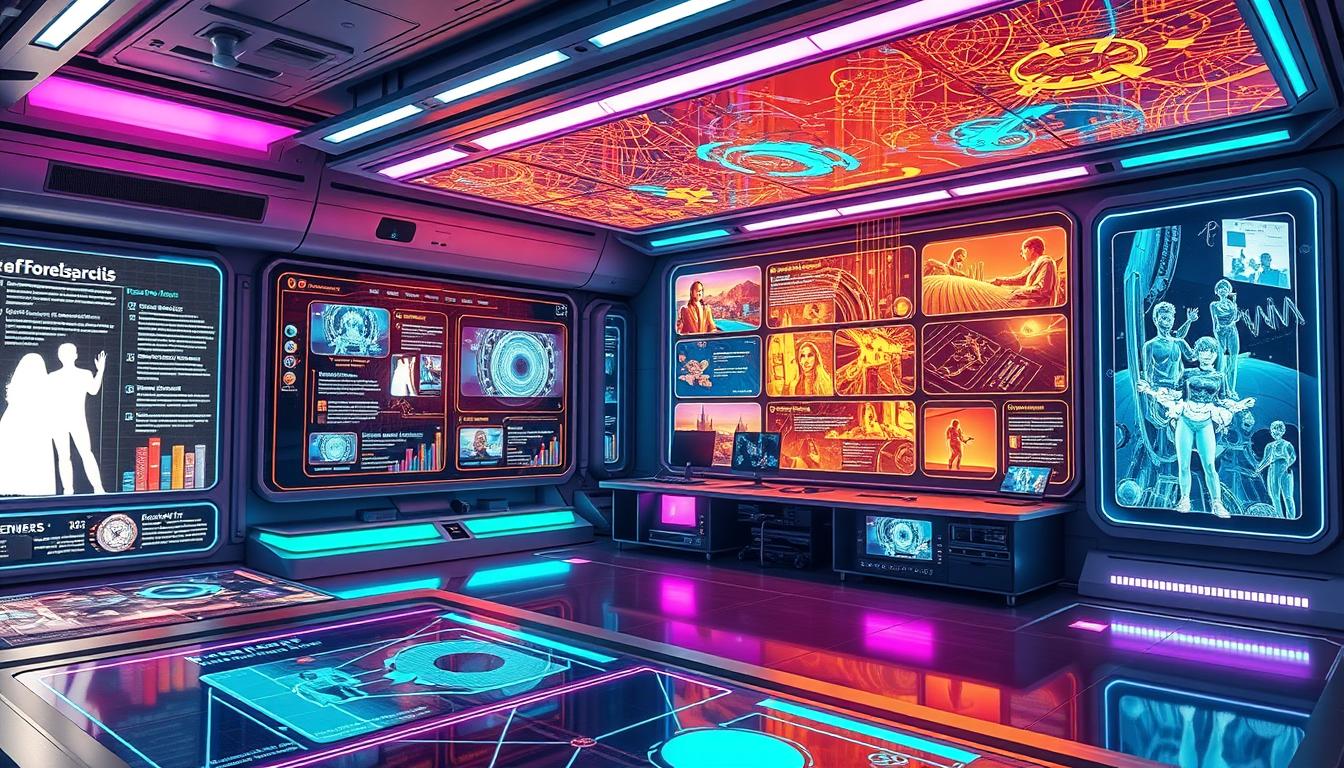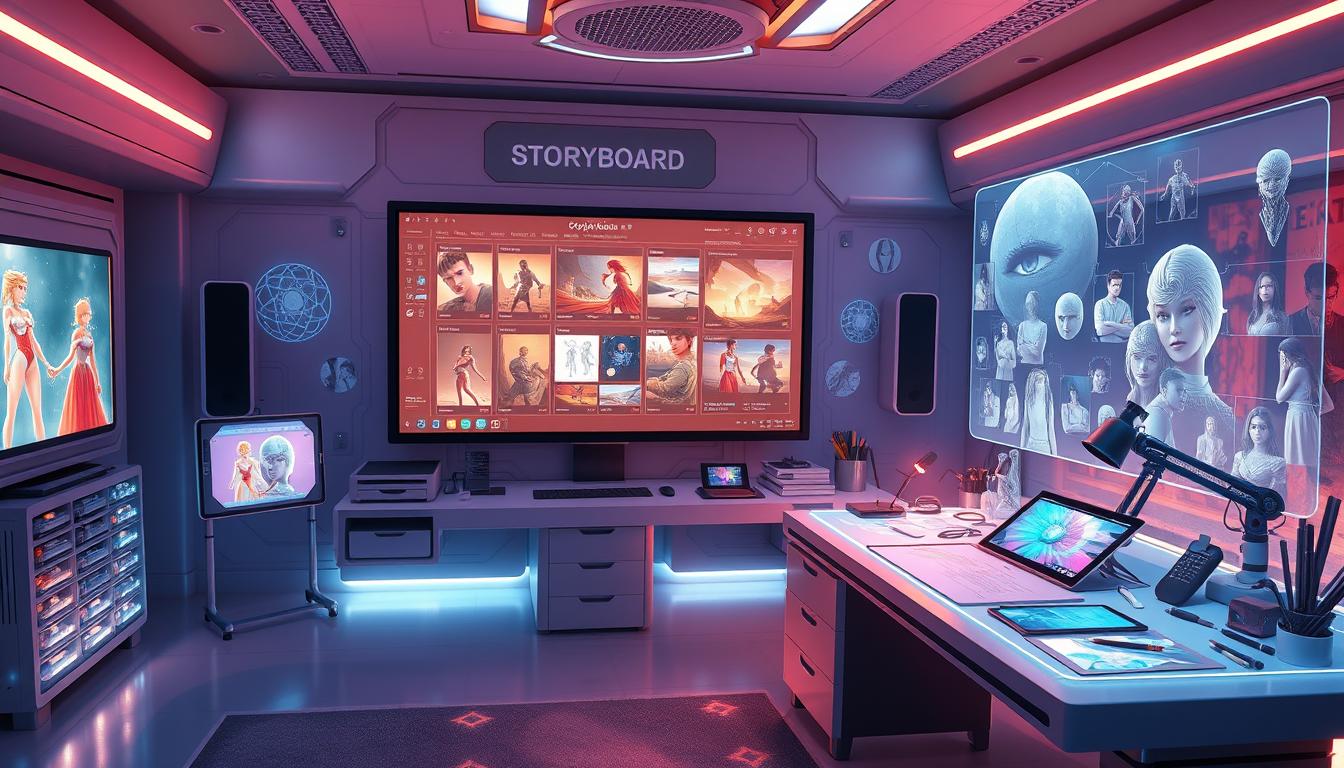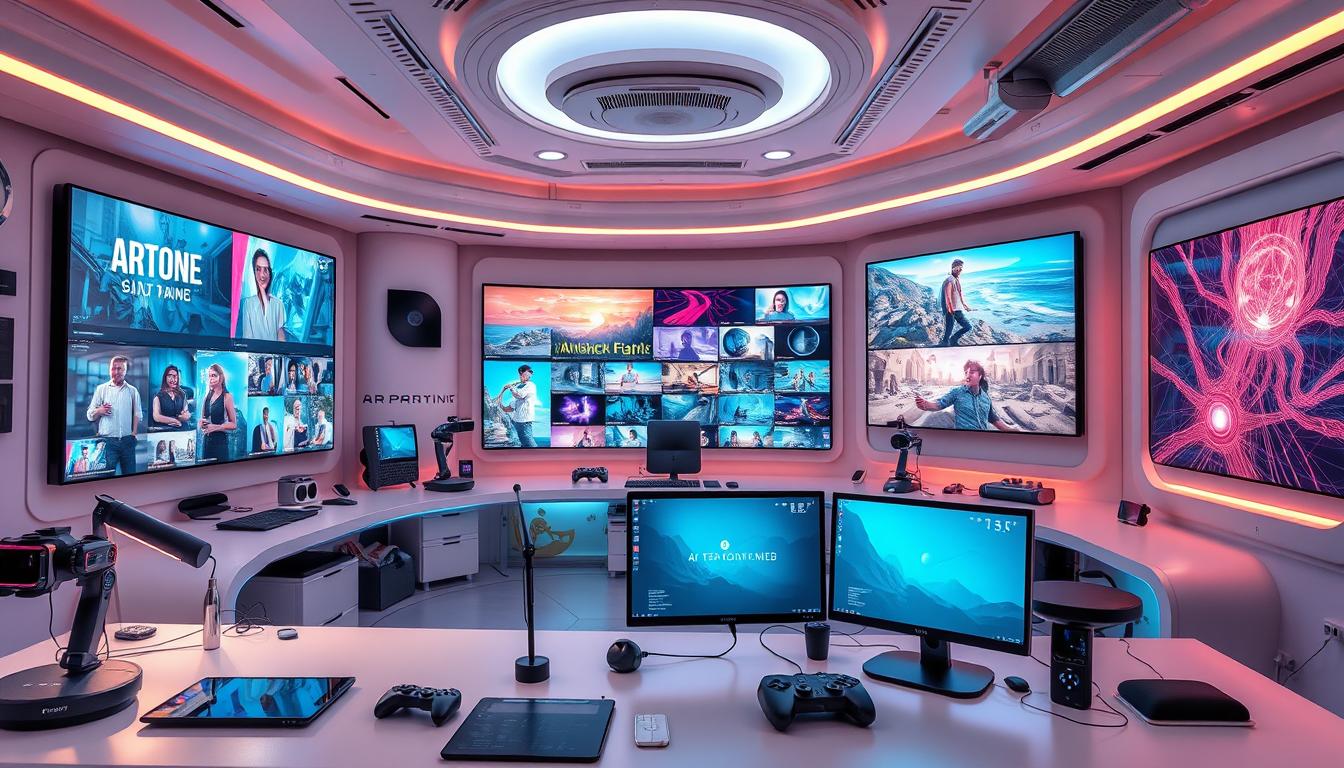AI has revolutionized storytelling in the digital world. It’s a powerful tool for creative professionals in storyboarding. AI enhances workflows, streamlines processes, and opens new possibilities in visual narratives.
This guide explores best practices for using AI in storyboarding. We’ll draw insights from industry experts to help you improve your creative work.
Key Takeaways
- Discover the definition and importance of AI-powered storyboarding for creative professionals
- Explore the key benefits of incorporating AI into your storyboarding workflow
- Learn best practices for defining project goals, understanding your target audience, and establishing clear objectives
- Understand the process of gathering and organizing data to fuel your AI-assisted storyboarding
- Identify the right AI tools and software to integrate with your traditional storyboarding methods
What is AI Storyboarding?
AI storyboarding blends artificial intelligence with storytelling. It streamlines ideation, visualization, and collaboration in the storyboarding process. This approach enhances creativity and efficiency for storytellers.
Definition and Importance
AI storyboarding uses AI-powered tools to create and develop storyboards. It’s useful for films, TV shows, ads, and animations. This method boosts creativity and efficiency in storytelling.
AI helps make data-driven decisions during the storyboarding stage. It unlocks new possibilities for storytellers to craft engaging narratives.
Key Benefits of AI Storyboarding
The key benefits of AI storyboarding include:
- Enhanced Creativity: AI tools generate new ideas and suggest story arcs. They provide visual inspirations, expanding creative possibilities for storytellers.
- Improved Efficiency: AI automates repetitive tasks and streamlines the storyboarding process. It enables real-time collaboration, boosting team productivity.
- Data-Driven Decision-Making: AI analyzes user data, market trends, and audience feedback. This helps create more effective and engaging stories.
- Collaborative Workflows: AI-enabled tools facilitate seamless teamwork among creative professionals. They help bring ideas to life more effectively.
AI empowers storytellers to explore new creative horizons. It helps craft narratives that truly resonate with the target audience.
Best Practices for AI Storyboarding
AI storyboarding can unlock amazing potential in storytelling. This section covers key strategies for seamless integration of AI tools in storyboarding. We’ll explore guidelines to help professionals effectively use this technology.
Here are essential practices for AI storyboarding:
- Establish Clear Objectives: Define your project’s goals upfront. Ensure AI use aligns with your creative vision and storytelling aims.
- Understand Your Audience: Research your target audience thoroughly. Use AI capabilities that match their preferences and needs.
- Embrace Collaborative Workflows: Foster open communication between your team and AI specialists. This optimizes the storyboarding process.
- Leverage AI for Ideation and Visualization: Use AI tools to generate diverse ideas. Explore different narrative paths and create compelling visual storyboards.
- Continuously Refine and Iterate: Regularly test and refine your storyboard with AI feedback. Use user insights to ensure your final product resonates.
These practices help professionals integrate AI into storyboarding smoothly. They unlock new possibilities for innovative storytelling and enhance the creative experience.
“Adopting best practices for AI storyboarding is not just about using the technology, but about leveraging it to its fullest potential to create truly transformative experiences.”
Successful AI storyboarding balances human creativity and tech capabilities. By using these practices, professionals can elevate their storytelling. They can create captivating experiences that truly engage their audience.
Defining Your Project Goals
Setting project goals is vital before starting AI-powered storyboarding. This step guides AI tool selection and application. It ensures your storyboarding aligns with your creative vision and business aims.
Define your target audience and establish clear objectives. This foundation will steer your AI-powered storyboarding efforts effectively. It helps create stories that resonate with your audience.
Understanding Your Target Audience
Knowing your audience is key to crafting engaging stories. Consider their demographics, interests, and pain points. Think about their preferred communication channels too.
This understanding helps tailor your storyboarding approach. It ensures your content meets their needs and preferences. Your stories will have a stronger impact as a result.
Establishing Clear Objectives
Define specific goals for your storyboarding process. Are you aiming to boost brand awareness or drive conversions? Maybe you want to enhance customer engagement?
Clear objectives help measure your AI-powered storyboarding success. They allow for data-driven decisions to improve your approach. Your storyboarding efforts become more focused and effective.
| Key Considerations for Defining Your Project Goals | Benefits |
|---|---|
|
|
By defining your project goals, understanding your target audience, and establishing clear objectives, you can lay the foundation for a successful AI-powered storyboarding process.
Gathering and Organizing Data
High-quality data is crucial for effective AI storyboarding. Curating a comprehensive data set empowers AI tools to generate accurate storyboard elements. This includes visual references, script outlines, character profiles, and other storytelling assets.
A robust data repository forms the basis for successful AI storyboarding. Consider these key steps:
- Gather a diverse range of visual references: Collect a library of images, illustrations, and concept art that can inspire and inform your storyboard development.
- Compile detailed script outlines: Ensure you have a well-structured script that outlines the narrative, dialogue, and scene descriptions.
- Create comprehensive character profiles: Develop detailed character biographies, including their physical characteristics, personalities, and backstories.
- Collect other storytelling assets: Gather any additional materials, such as mood boards, color palettes, or sound effects, that can enhance the overall storytelling experience.
Organizing data into a central, accessible repository streamlines the AI storyboarding process. This empowers tools to generate coherent, visually compelling content.
“The quality of your data directly impacts the quality of your AI storyboarding output. Invest time in curating a comprehensive and well-structured data set for the best results.”
Quality data lays the groundwork for captivating AI storyboarding. Careful asset gathering and organization set the stage for AI-created storyboard elements.

Choosing the Right AI Tools
Selecting the right AI tools is crucial for successful storyboarding. This section will help you evaluate AI storyboarding software. We’ll consider ease of use, features, and workflow compatibility.
Evaluating AI Storyboarding Software
When choosing AI storyboarding tools, consider these key factors:
- Ease of use: Look for software with a user-friendly interface. This makes it easier for your team to adopt.
- Feature set: Check for automated scene suggestions and digital sketching tools. Integration with other design software is also important.
- Compatibility: Ensure the tool integrates well with your existing workflows. This minimizes disruptions and enables a smooth transition.
- Customization: Choose tools that offer personalization options. This allows you to tailor the software to your project needs.
- Collaboration: Seek features that enable real-time teamwork. This helps your team work together effectively on storyboarding.
Integrating AI with Traditional Methods
Find ways to blend AI tools with traditional storyboarding methods. This balance can create a powerful creative process. It combines AI efficiency with the human touch of traditional techniques.
Here are strategies to integrate AI with traditional storyboarding:
- Use AI for initial ideas and scene generation. Then, refine the storyboard with your team’s creative input.
- Apply AI tools for digital sketching and shot sequencing. Maintain control over the narrative and visual direction.
- Incorporate AI-generated assets into your traditional workflow. This can include character designs or background elements.
- Foster collaboration between your team and AI tools. This creates a symbiotic relationship that leverages both approaches.
Carefully select AI tools and integrate them with traditional methods. This approach can boost creativity and efficiency in your storyboarding process.
Creating Compelling Narratives
AI storyboarding enhances narrative-building by creating captivating characters and dynamic plot twists. It infuses storyboards with emotionally resonant moments, elevating the storytelling process.
Artificial intelligence can help craft engaging story arcs. It adds depth and intrigue to your narratives, making them more compelling for audiences.
Crafting Engaging Story Arcs
AI storyboarding transforms the development of intricate and captivating story arcs. Consider these best practices to improve your storytelling:
- Utilize AI-powered ideation tools to generate novel plot points and narrative elements that challenge traditional storytelling conventions.
- Employ AI algorithms to analyze character archetypes and dynamics, ensuring your cast is well-rounded and relatable.
- Leverage AI-driven pacing and tension analysis to create a narrative flow that keeps your audience hooked from beginning to end.
- Integrate AI-generated emotional cues to infuse your storyboard with moments of genuine pathos, humor, and suspense.
AI helps create stories that captivate and inspire. It ensures your narratives leave a lasting impression on your audience.
With AI, you can craft unique and engaging stories. Your audience will be drawn into the world you create.
“AI storyboarding has revolutionized the way I approach narrative development. It’s like having a creative partner that can see the bigger picture and help me craft truly engaging story arcs.”

Visualizing Your Storyboard
AI tools can boost your storyboarding skills. They help create strong visuals for your story. We’ll explore best practices for storyboard layouts and using AI-generated assets.
We’ll also look at ways to blend digital and traditional elements. This can make your storyboard more effective and engaging.
Best Practices for Storyboard Layouts
A good storyboard layout is key to telling your story well. It helps your audience follow along easily. Here are some tips to make your storyboard shine:
- Utilize a consistent grid-based structure: Establish a clear grid system to ensure a cohesive and balanced layout, making it easier for your audience to follow the flow of the story.
- Incorporate visual hierarchy: Prioritize key moments or scenes by using different panel sizes, placements, and emphasis to guide the viewer’s attention.
- Leverage AI-generated assets: Incorporate AI-powered tools to create high-quality illustrations, background elements, and visual effects that seamlessly integrate with your storyboard.
- Experiment with panel arrangements: Play with different panel shapes, sizes, and overlapping techniques to create a dynamic and visually engaging storyboard.
- Maintain a clear, legible presentation: Ensure that your text, annotations, and other textual elements are easily readable and integrated into the overall layout.
| Effective Storyboard Layout Elements | Benefits |
|---|---|
| Grid-based structure | Consistent and organized layout |
| Visual hierarchy | Emphasis on key moments and scenes |
| AI-generated assets | High-quality visuals and seamless integration |
| Varied panel arrangements | Dynamic and engaging presentation |
| Clear, legible text | Easy readability and integration |
These tips will help you create a stunning storyboard. Your audience will be drawn in by the visuals. Your story will come to life in a whole new way.
Best Practices for AI Storyboarding
This section covers best practices for AI storyboarding. It combines insights from previous sections. Use it as a guide to implement AI-powered workflows in your creative process.
Here are key practices for successful AI storyboarding:
- Embrace a Collaborative Approach: Work with your team to succeed in AI storyboarding. Include creatives, experts, and tech specialists to gain diverse viewpoints.
- Iterative Development: Treat AI storyboarding as an ongoing process. Keep refining your work based on feedback and new strategies.
- Continuous Learning: Keep up with AI and storyboarding advances. Attend events, join online groups, and take classes to grow your skills.
- Measure and Optimize: Set clear goals for your AI storyboarding projects. Analyze results often and use data to improve your workflow.
These practices will help you use AI to create great storyboards. You’ll boost creativity and efficiency in your work.
“The true sign of intelligence is not knowledge but imagination.” – Albert Einstein
AI storyboarding is always changing. Stay flexible and eager to learn. This will help you get the most out of this amazing technology.

Collaborating with Your Team
AI storyboarding thrives on teamwork. Good communication and coordination are key when using AI tools. Let’s explore how to create a collaborative space that makes the most of AI-assisted storytelling.
Effective Communication Strategies
Set up clear communication rules for your team. Hold regular meetings to share updates and discuss issues. Listen to your team’s ideas and encourage open talks.
Keep communication transparent to align on project goals. This ensures everyone understands the project’s direction.
Try these strategies to boost team collaboration:
- Utilize project management tools to track tasks, deadlines, and team responsibilities.
- Establish a shared document repository for easy access to project files and resources.
- Encourage asynchronous collaboration by setting up dedicated channels for feedback and idea exchange.
- Foster a creative environment that welcomes diverse ideas and constructive criticism.
These practices help your team use AI tools in storyboarding smoothly. They lead to more unified and creative storytelling.
| Communication Best Practices | Benefits |
|---|---|
| Regular team meetings | Align on project goals and progress |
| Shared project management tools | Streamline task tracking and coordination |
| Dedicated feedback channels | Facilitate asynchronous collaboration |
| Fostering a creative environment | Encourage diverse ideas and innovation |
“Effective collaboration is the key to unlocking the full potential of AI-powered storytelling. By prioritizing communication and fostering a creative team dynamic, you can harness the power of technology to craft truly captivating narratives.”
Testing and Refining Your Storyboard
AI-powered storyboards need constant testing and improvement. This ensures your narrative succeeds. Let’s explore how to test, get feedback, and enhance your storyboard.
Effective testing combines user feedback and data analysis. Start with user testing sessions. Gather insights from your target audience on clarity and engagement.
Here’s a multi-faceted approach to storyboard testing:
- Gather Diverse Feedback: Seek input from various stakeholders, including experts, collaborators, and potential customers. This helps identify improvements and ensures your storyboard resonates with the audience.
- Analyze User Engagement: Use analytics tools to track user interactions. Monitor metrics like time spent per scene and drop-off rates. These help pinpoint areas needing refinement.
- Iterate and Refine: Use collected feedback and data to improve your storyboard. Adjust narrative flow, enhance visuals, or fine-tune the user experience.
Creating a successful AI-powered storyboard is ongoing. It involves testing, learning, and refining. This approach ensures your narrative impacts your audience effectively.
“The key to creating an effective AI-powered storyboard is to continuously test, gather feedback, and make thoughtful refinements. This process helps you strengthen the narrative, enhance the user experience, and ultimately, achieve your desired outcomes.”

Stay vigilant and adaptable when testing your AI-powered storyboard. Commit to delivering a compelling narrative. This iterative approach will help create a captivating storyboard.
Conclusion
AI storyboarding offers powerful tools to enhance your creative process. It combines core storytelling principles with advanced technology. This guide helps you innovate and create captivating visual narratives.
Clear goals, relevant data, and the right AI tools are crucial. These elements help craft compelling stories that grab your audience. Visualizing, collaborating, and refining your work is vital in today’s fast-paced creative world.
Success in AI storyboarding comes from experimenting and learning. Embrace this technology to unlock new creative possibilities. Streamline your processes and take your brand’s storytelling to new heights.

